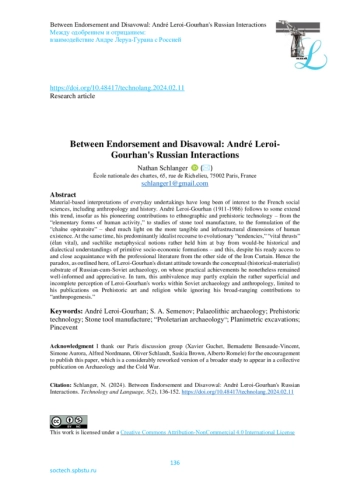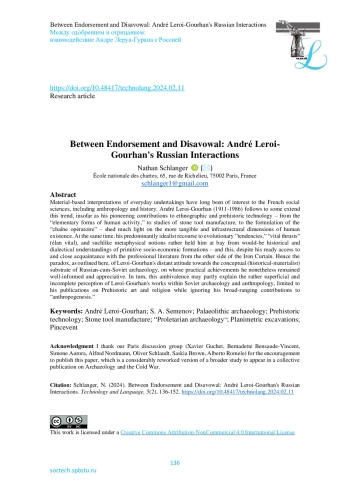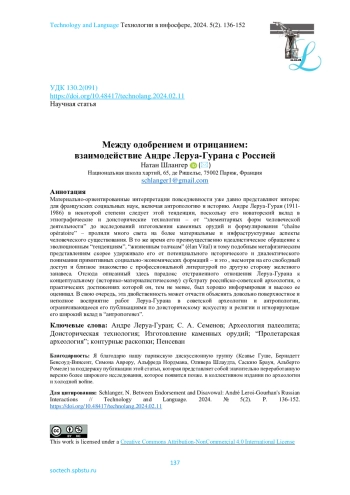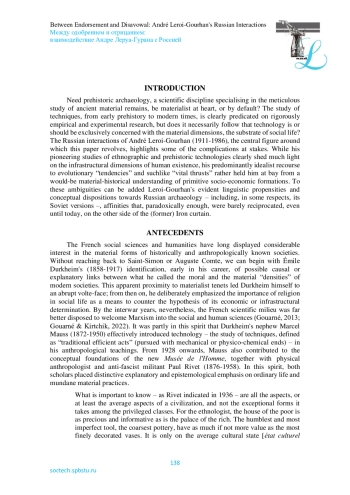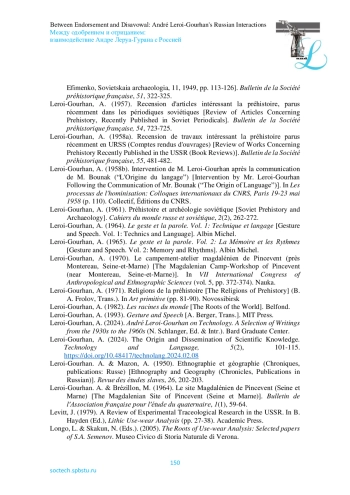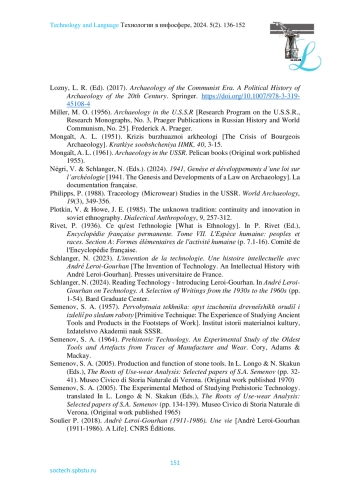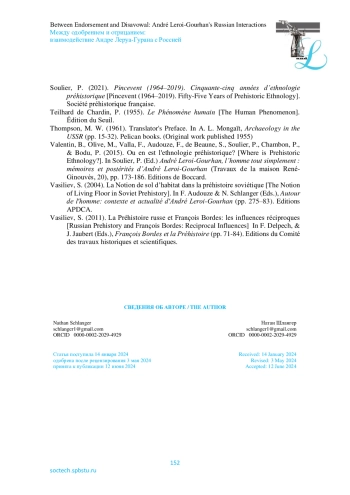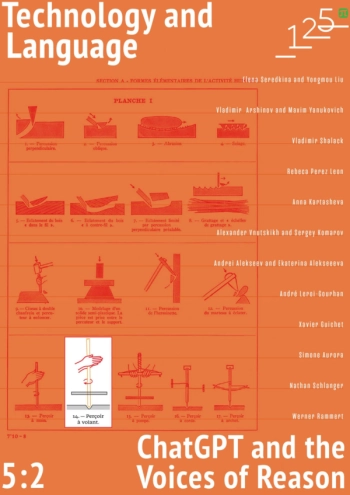Material-based interpretations of everyday undertakings have long been of interest to the French social sciences, including anthropology and history. André Leroi-Gourhan (1911-1986) follows to some extend this trend, insofar as his pioneering contributions to ethnographic and prehistoric technology – from the “elementary forms of human activity,” to studies of stone tool manufacture, to the formulation of the “chaîne opératoire” – shed much light on the more tangible and infrastructural dimensions of human existence. At the same time, his predominantly idealist recourse to evolutionary “tendencies,” “vital thrusts” (élan vital), and suchlike metaphysical notions rather held him at bay from would-be historical and dialectical understandings of primitive socio-economic formations – and this, despite his ready access to and close acquaintance with the professional literature from the other side of the Iron Curtain. Hence the paradox, as outlined here, of Leroi-Gourhan’s distant attitude towards the conceptual (historical-materialist) substrate of Russian-cum-Soviet archaeology, on whose practical achievements he nonetheless remained well-informed and appreciative. In turn, this ambivalence may partly explain the rather superficial and incomplete perception of Leroi-Gourhan’s works within Soviet archaeology and anthropology, limited to his publications on Prehistoric art and religion while ignoring his broad-ranging contributions to “anthropogenesis.”
Идентификаторы и классификаторы
Need prehistoric archaeology, a scientific discipline specialising in the meticulous study of ancient material remains, be materialist at heart, or by default? The study of techniques, from early prehistory to modern times, is clearly predicated on rigorously empirical and experimental research, but does it necessarily follow that technology is or should be exclusively concerned with the material dimensions, the substrate of social life? The Russian interactions of André Leroi-Gourhan (1911-1986), the central figure around which this paper revolves, highlights some of the complications at stakes. While his pioneering studies of ethnographic and prehistoric technologies clearly shed much light on the infrastructural dimensions of human existence, his predominantly idealist recourse to evolutionary “tendencies” and suchlike “vital thrusts” rather held him at bay from a would-be material-historical understanding of primitive socio-economic formations. To these ambiguities can be added Leroi-Gourhan’s evident linguistic propensities and conceptual dispositions towards Russian archaeology – including, in some respects, its Soviet versions –, affinities that, paradoxically enough, were barely reciprocated, even until today, on the other side of the (former) Iron curtain.
Список литературы
1. Alymov, S. (2022). Cold War Anthropology from Both Sides of the Iron Curtain. Revue d’histoire des sciences humaines, 40, 85-109. DOI: 10.4000/rhsh.6853 EDN: LHBDLZ
2. Audouze, F. (2002). Leroi-Gourhan, a Philosopher of Technique and of Evolution. Journal of Archaeological Research, 10, 277-306. https://doi.org/10.1023/A:1020599009172. EDN: BBXYZZ
3. Audouze, F. & Schlanger, N. (2004).Introduction: singularité et diversité [Introduction: singularity and diversity]. In F. Audouze & N. Schlanger (Eds.), Autour de l’homme: contexte et actualité d’André Leroi-Gourhan (pp. 17-29). Editions APDCA.
4. Ballinger, M., Bignon-Lau, O., Bodu, P., Debout, G., Dumarçay, G., Hardy, M., Julien, M., Karlin, C., Malgarini, R., Orliac, M., Peschaux, C., Soulier, P., & Valentin, B. (2014). Pincevent (1964-2014): 50 années de recherches sur la vie des Magdaléniens [Pincevent (1964-2014): 50 Years of Research on the Life of the Magdalenians]. Société préhistorique française.
5. Barbe, N. & Bert, J.-F. (Eds.). (2011). Penser le concret. André Leroi-Gourhan, André-Georges Haudricourt, Charles Parain [Thinking concretely. André Leroi-Gourhan, André-Georges Haudricourt, Charles Parain]. Creaphis.
6. Bergson, H. (1907). L’Évolution créatrice [Creative Evolution]. Presses universitaires de France.
7. Bertrand, F. (2002). L’Anthropologie soviétique des années 20-30. Configurations d’une rupture [Soviet Anthropology of the 20s and 30s. Configurations of a Rupture]. Presses universitaires de Bordeaux.
8. Bordes, F. (1967). Considérations sur la Typologie et les techniques dans le Paléolithique [Considerations on Palaeolithic Typology and Techniques]. Quartär, 18, 25-55.
9. Boriskovski, P. I. (1965). À propos des récents progrès des études paléolithiques en U.R.S.S. [About Recent Advances in Paleolithic Studies in the U.S.S.R.]. L’Anthropologie, 6, 5-30.
10. Bounak, V. V. (1958). L’origine du langage [The Origin of Language]. In Les Processus de l’hominisation: colloques internationaux du CNRS, Paris 19-23 mai 1958 (pp. 99-111). CNRS.
11. Bulkin V. A., Klejn, L. S., & Lebedev, G. S. (1982). Attainments and Problems of Soviet Archaeology. World Archaeology, 13(3), 272-295. EDN: XMFLBX
12. Davis, R. S. (1983). Theoretical Issues in Contemporary Soviet Paleolithic Archaeology. Annual Review of Anthropology, 12, 403-428. DOI: 10.1146/annurev.an.12.100183.002155
13. Demoule, J.-P., & Schnapp, A. (2024). Qui a peur de l’archéologie ? La France face à son passé [Who is Afraid of Archaeology? France Facing its Past.]. Les Belles Lettres.
14. Efimenko, P. P. (1949). Iz materialov paleoleticheskogo poseleniya Kostenki 1 [From the Materials of the Paleolithic Settlement of Kostenki 1]. Sovietskaia archeologia, 11, 113-126.
15. Engels, F. (1883). Dialectics of Nature. Progress Press.
16. Gouarné, I. (2013). L’Introduction du marxisme en France. Philosoviétisme et sciences humaines, 1920-1939 [The Introduction of Marxism in France. Philosovietism and Human Sciences, 1920-1939]. Presses universitaires de Rennes.
17. Gouarné, I. & Kirtchik, O. (Ed). (2022). Réformer (avec) les sciences sociales en Union soviétique [Reforming (with) the Social Sciences in the Soviet Union]. Revue d’histoire des sciences humaines, 40. DOI: 10.4000/rhsh.6744
18. Haudricourt, A.-G. (1987). La Technologie, science humaine. Recherches d’histoire et d’ethnologie des techniques [Technology, A Human Science. Historical and Ethnological Studies of Techniques]. Maison des Sciences de l’Homme.
19. Haudricourt, A.-G. & Dibie, P. (1987). Les Pieds sur terre [With Feet on the Ground]. Métailié.
20. Haudricourt, A.-G. & Bertrand, F. (2002). Entretien (décembre 1994) [Interview (December 1994)]. In Bertrand, & F. (Ed.), L’Anthropologie soviétique des années 20-30. Configurations d’une rupture (pp. 245-255), Presses universitaires de Bordeaux.
21. Karlin, C. & Julien, M. (2012). Les Campements de Pincevent: Entre archéologie et anthropologie [The Pincevent Camps: Between Archaeology and Anthropology]. In N. Schlanger, & A. C. Taylor (Eds.), La Préhistoire des autres: Perspectives archéologiques et anthropologiques (pp. 185-200). La Découverte.
22. Klejn, L. S. (2012). Soviet Archaeology. Trends, Schools and History. Oxford University Press.
23. Klejn, L. S. (2017). Archaeology in Soviet Russia. In L. Lozny (Ed), Archaeology of the Communist Era. A Political History of Archaeology of the 20th Century, Springer, pp. 59-99.
24. Krutkin, V. L. (2019). “Human Corporeality and the Technologies of Light Writing”, Forum 38: Body and Technology. Forum for Anthropology and Culture, 15, 32-42. EDN: BEXCFR
25. Lecourt, D. (1977). Proletarian Science? The Case of Lysenko [B. Brewster, Trans.; L. Althusser, Intr.]. NKB and Humanities Press.
26. Leroi-Gourhan, A. (1936). L’Homme et la nature [Humans and Nature]. In P. Rivet (Ed.), Encyclopédie française permanente. Vol. 7, L’Espèce humaine: Peoples et races. Part I, “L’Humanité d’aujourd’hui”. Section A, “Les Formes élémentaires de l’activité humaine” (pp. 7.10.3-16, 7.12.1-4).Comité de l’Encyclopédie française édition.
27. Leroi-Gourhan, A. (1943). L’Homme et la matière. Vol. 1., Évolution et techniques [Humans and Matter. Vol. 1., Evolution and Techniques]. Albin Michel.
28. Leroi-Gourhan, A. (1945). Milieu et techniques. Vol. 2, Évolution et techniques [Milieu and Techniques. Vol. 2, Evolution and techniques]. Albin Michel.
29. Leroi-Gourhan, A. (1952). Homo faber... Homo sapiens. Revue de Synthèse, 30, 79-102.
30. Leroi-Gourhan, A. (1953). Origine et diffusion de la connaissance scientifique [The Origins and Dissemination ffusion of Scientific Knowledge]. Structure et Évolution des Techniques, 33-34, 1-16.
31. Leroi-Gourhan, A. (1954). Traduction de Matériaux sur le peuplement paléolithique de Kostienki I, par P.P. Efimenko, Sovietskaia archaeologia, 11, 1949, pp. 113-126 [Translation of Materials on the Paleolithic Settlement of Kostienki I, by P.P. Efimenko, Sovietskaia archaeologia, 11, 1949, pp. 113-126]. Bulletin de la Société préhistorique française, 51, 322-325.
32. Leroi-Gourhan, A. (1957). Recension d’articles intéressant la préhistoire, parus récemment dans les périodiques soviétiques [Review of Articles Concerning Prehistory, Recently Published in Soviet Periodicals]. Bulletin de la Société préhistorique française, 54, 723-725.
33. Leroi-Gourhan, A. (1958a). Recension de travaux intéressant la préhistoire parus récemment en URSS (Comptes rendus d’ouvrages) [Review of Works Concerning Prehistory Recently Published in the USSR (Book Reviews)]. Bulletin de la Société préhistorique française, 55, 481-482.
34. Leroi-Gourhan, A. (1958b).Intervention de M. Leroi-Gourhan après la communication de M. Bounak (“L’Origine du langage”) [Intervention by Mr. Leroi-Gourhan Following the Communication of Mr. Bounak (“The Origin of Language”)]. In Les processus de l’hominisation: Colloques internationaux du CNRS, Paris 19-23 mai 1958 (p. 110). Collectif, Éditions du CNRS.
35. Leroi-Gourhan, A. (1961). Préhistoire et archéologie soviétique [Soviet Prehistory and Archaeology]. Cahiers du monde russe et soviétique, 2(2), 262-272.
36. Leroi-Gourhan, A. (1964). Le geste et la parole. Vol. 1: Technique et langage [Gesture and Speech. Vol. 1: Technics and Language]. Albin Michel.
37. Leroi-Gourhan, A. (1965). Le geste et la parole. Vol. 2: La Mémoire et les Rythmes [Gesture and Speech. Vol. 2: Memory and Rhythms]. Albin Michel.
38. Leroi-Gourhan, A. (1970). Le campement-atelier magdalénien de Pincevent (près Montereau, Seine-et-Marne) [The Magdalenian Camp-Workshop of Pincevent (near Montereau, Seine-et-Marne)]. In VII International Congress of Anthropological and Ethnographic Sciences (vol. 5, pp. 372-374). Nauka.
39. Leroi-Gourhan, A. (1971). Religions de la préhistoire [The Religions of Prehistory] (B. A. Frolov, Trans.). In Art primitive (pp. 81-90). Novossibirsk.
40. Leroi-Gourhan, A. (1982). Les racines du monde [The Roots of the World]. Belfond.
41. Leroi-Gourhan, A. (1993). Gesture and Speech [A. Berger, Trans.]. MIT Press.
42. Leroi-Gourhan, A. (2024). André Leroi-Gourhan on Technology. A Selection of Writings from the 1930s to the 1960s (N. Schlanger, Ed. & Intr.). Bard Graduate Center.
43. Leroi-Gourhan, A. (2024). The Origin and Dissemination of Scientific Knowledge. Technology and Language, 5(2), 101-115. DOI: 10.48417/technolang.2024.02.08 EDN: JQBKXU
44. Leroi-Gourhan. A. & Mazon, A. (1950). Ethnographie et géographie (Chroniques, publications: Russe) [Ethnography and Geography (Chronicles, Publications in Russian)]. Revue des études slaves, 26, 202-203.
45. Leroi-Gourhan. A. & Brézillon, M. (1964). Le site Magdalénien de Pincevent (Seine et Marne) [The Magdalenian Site of Pincevent (Seine et Marne)]. Bulletin de l’Association française pour l’étude du quaternaire, 1(1), 59-64.
46. Levitt, J. (1979). A Review of Experimental Traceological Research in the USSR. In B. Hayden (Ed.), Lithic Use-wear Analysis (pp. 27-38). Academic Press.
47. Longo, L. & Skakun, N. (Eds.). (2005). The Roots of Use-wear Analysis: Selected papers of S.A. Semenov. Museo Civico di Storia Naturale di Verona.
48. Lozny, L. R. (Ed). (2017). Archaeology of the Communist Era. A Political History of Archaeology of the 20th Century. Springer. DOI: 10.1007/978-3-319-45108-4
49. Miller, M. O. (1956). Archaeology in the U.S.S.R [Research Program on the U.S.S.R., Research Monographs, No. 3, Praeger Publications in Russian History and World Communism, No. 25]. Frederick A. Praeger.
50. Mongaït, A. L. (1951). Krizis burzhuaznoi arkheologi [The Crisis of Bourgeois Archaeology]. Kratkiye soobshcheniya IIMK, 40, 3-15.
51. Mongaït, A. L. (1961). Archaeology in the USSR. Pelican books (Original work published 1955).
52. Négri, V. & Schlanger, N. (Eds.). (2024). 1941, Genèse et développements d’une loi sur l’archéologie [1941. The Genesis and Developments of a Law on Archaeology]. La documentation française.
53. Philipps, P. (1988). Traceology (Microwear) Studies in the USSR. World Archaeology, 19(3), 349-356.
54. Plotkin, V. & Howe, J. E. (1985). The unknown tradition: continuity and innovation in soviet ethnography. Dialectical Anthropology, 9, 257-312.
55. Rivet, P. (1936). Ce qu’est l’ethnologie [What is Ethnology]. In P. Rivet (Ed.), Encyclopédie française permanente. Tome VII. L’Espèce humaine: peoples et races. Section A: Formes élémentaires de l’activité humaine (p. 7.1-16).Comité de l’Encyclopédie française.
56. Schlanger, N. (2023). L’invention de la technologie. Une histoire intellectuelle avec André Leroi-Gourhan [The Invention of Technology. An Intellectual History with André Leroi-Gourhan]. Presses universitaire de France.
57. Schlanger, N. (2024). Reading Technology - Introducing Leroi-Gourhan. In André Leroi-Gourhan on Technology. A Selection of Writings from the 1930s to the 1960s (pp. 1-54). Bard Graduate Center.
58. Semenov, S. A. (1957). Pervobytnaia tekhnika: opyt izucheniia drevneĭshikh orudiĭ i izdeliĭ po sledam raboty [Primitive Technique: The Experience of Studying Ancient Tools and Products in the Footsteps of Work]. Institut istorii materialnoi kultury, Izdatelstvo Akademii nauk SSSR.
59. Semenov, S. A. (1964). Prehistoric Technology. An Experimental Study of the Oldest Tools and Artefacts from Traces of Manufacture and Wear. Cory, Adams & Mackay.
60. Semenov, S. A. (2005). Production and function of stone tools. In L. Longo & N. Skakun (Eds.), The Roots of Use-wear Analysis: Selected papers of S.A. Semenov (pp. 32-41). Museo Civico di Storia Naturale di Verona. (Original work published 1970).
61. Semenov, S. A. (2005). The Experimental Method of Studying Prehistoric Technology. translated In L. Longo & N. Skakun (Eds.), The Roots of Use-wear Analysis: Selected papers of S.A. Semenov (pp. 134-139). Museo Civico di Storia Naturale di Verona. (Original work published 1965).
62. Soulier P. (2018). André Leroi-Gourhan (1911-1986). Une vie [André Leroi-Gourhan (1911-1986). A Life]. CNRS Éditions.
63. Soulier, P. (2021). Pincevent (1964-2019). Cinquante-cinq années d’ethnologie préhistorique [Pincevent (1964-2019). Fifty-Five Years of Prehistoric Ethnology]. Société préhistorique française.
64. Teilhard de Chardin, P. (1955). Le Phénomène humain [The Human Phenomenon]. Édition du Seuil.
65. Thompson, M. W. (1961). Translator’s Preface. In A. L. Mongaït, Archaeology in the USSR (pp. 15-32). Pelican books. (Original work published 1955).
66. Valentin, B., Olive, M., Valla, F., Audouze, F., de Beaune, S., Soulier, P., Chambon, P., & Bodu, P. (2015). Ou en est l’ethnologie préhistorique? [Where is Prehistoric Ethnology?]. In Soulier, P. (Ed.) André Leroi-Gourhan, l’homme tout simplement: mémoires et postérités d’André Leroi-Gourhan (Travaux de la maison René-Ginouvès, 20), pp. 173-186. Editions de Boccard.
67. Vasiliev, S. (2004). La Notion de sol d’habitat dans la préhistoire soviétique [The Notion of Living Floor in Soviet Prehistory]. In F. Audouze & N. Schlanger (Eds.), Autour de l’homme: contexte et actualité d’André Leroi-Gourhan (pp. 275-83). Editions APDCA.
68. Vasiliev, S. (2011). La Préhistoire russe et François Bordes: les influences réciproques [Russian Prehistory and François Bordes: Reciprocal Influences] In F. Delpech, & J. Jaubert (Eds.), François Bordes et la Préhistoire (pp. 71-84). Editions du Comité des travaux historiques et scientifiques.
Выпуск
Другие статьи выпуска
This paper claims to show that the making of technology and the material agency of technical objects can be analyzed analogously to the making of meaning through words and speech acts. It proposes the development of a more comprehensive view on the making and working of technology that connects the social pragmatist approach of technical practice and symbolic interagency (Kant, Dewey, Mead) with the linguistic concept of pragmatics and speech acts (Peirce, Wittgenstein, Austin). Both, speech acts and technical acts can be considered as two modes of meaning-making in the social construction of reality. Furthermore, the paper exhibits some parallels between the objectification processes of language and technology. It emphasizes how both evolve from early stages of signs and tools in practical contexts to encoded collections of grammatical rules and technological toolslater on. Doing things with concrete things (technology) reveals two different modes of “efficacy” (Jullien). There is implicit experienced efficacy in the language of directed material forces and causes and also an explicit ascribed efficacy in the language of instituted ends–means relations. The text explores the analogy between language and technology through the lenses of semantics, syntax, pragmatics, and grammar. It emphasizes the importance of such an extended pragmatist/pragmatics approach in the face of new technologies that exhibits a high degree of self-activity, more modes of intra-action between physical and digital objects, and a growing interactivity at interfaces with human actors and environmental factors. They can be more appropriately understood, conceptualized, and also designed as sociotechnical constellations of distributed agencies between people, machines, and programs.
In what follows, I will try to offer a brief overview of the relationships between some of Leroi-Gourhan’s anthropological insights on technology and some of the fundamental theoretical claims that form the general framework of structural linguistics. This hermeneutical movement runs an evident risk, which needs to be addressed and overcome: the risk of including Leroi-Gourhan’s works in the wide range of the structuralist corpus. For this reason, in the introduction I clarify what I mean by “structuralism” so that, in the subsequent sections, I can try to show the epistemological relationship between Leroi-Gourhan’s ethnology and the “structuralist turn,” as described in the introduction. To this end, I will point out the possible theoretical influence exerted by structural linguistics, and especially by the structural phonology developed within the Prague linguistic circle, on Leroi-Gourhan’s conceptual toolbox. More specifically, in the paper, I will focus on some passages of La geste et la parole (1964), which I will consider in connection with two more minor and older texts, namely Origine et diffusion de la connaissance scientifique (1953) and L’homme et la nature, an article published in 1936 in the Encyclopédie française.
The emphasis on technical artifacts is a hallmark of contemporary philosophy of technology. How can Leroi-Gourhan’s conceptualization of the technical object enrich current discussions among philosophers of technology? This article aims not to exhaustively address this question but to briefly outline how LeroiGourhan, as an ethnologist, reconfigures the concept of the technical object inherited from ethnology. The article begins by presenting Leroi-Gourhan’s ambition to revisit the central question of ethnology: what is the origin of the division of the human mass into distinct ethnic units called “peoples”, distributed across the globe? According to Leroi-Gourhan, ethnology did not divide humanity at its natural junctures, leading to inaccurate historical conclusions. For him, “peoples” are not fixed and uniform entities defined by constant, specific characteristics. Instead, they arise from the temporary convergence of traits, such as language and technology, which have their own independent existence. These traits may come together at a certain point, but beyond that, they diverge. Ethnology should focus on these traits, not on the “peoples.” In particular, technology serves as a reliable indicator of how the human mass has been divided and dispersed across space and time. However, to draw solid conclusions on this matter, it is essential to approach the extensive technical documentation with a rigorous method of classification and analysis. The article examines this method, leading Leroi-Gourhan to redefine the very concept of the technical object. The article highlights Leroi-Gourhan’s focus on the concepts of “fact” and “tendency” in his analysis of technical objects. These objects are viewed both as solutions to general human challenges in transforming matter (representing “tendencies”) and as culturally significant items with varying “degrees of fact.” Thus, Leroi-Gourhan assigned a dual nature to technical objects, but in an interestingly different way than those analytical philosophers who have been discussing the dual nature of artefacts.
Андре Леруа-Гуран (1911-1986) - французский этнолог, специалист по истории доисторических времен и палеоантрополог, которого сегодня также ценят за его влияние на философию технологии. Его первые публикации о “L’Homme et la matière” и “Milieu et techniques” (1943, 1945) закрепили за ним репутацию специалиста по изучению материальных цивилизаций и сравнительному анализу технологий. Эта точка зрения была обогащена эволюционными и антропологическими соображениями в его наиболее известной работе “Le geste et la parole” (1964, 1965). Эта книга вышла на английском языке под названием “Gesture and Speech” в 1993 году, но не все его соответствующие публикации были переведены, и некоторые аспекты его технологического подхода остаются малоизвестными. Публикуемый здесь перевод его лекции, прочитанной в марте 1952 года в Доме наук в Париже в рамках цикла лекций на тему “Структуры Вселенной и их научное восприятие”, является возможностью подчеркнуть интерес и актуальность Леруа-Гурана для современных размышлений о технологиях. Например, совместная тактильная и когнитивная “материальная вовлеченность”, по мнению Леруа-Гурана, характерна для специфического человеческого производства, для “материально-творческой деятельности”, которой занимались ремесленники всех времен. Здесь мы можем отметить приверженность Леруа-Гурана философскому принципу Анри Бергсона, касающемуся эпистемологического примата действия над созерцанием и, следовательно, активного, динамичного, жизненно важного происхождения знания.
В статье рассматривается вопрос о терминологической корректности понятия “генеративный искусственный интеллект”. Дискуссия позволяет сделать вывод о том, что преждевременно утверждать о замене человека GPT-ассистентами (Generative Pre-trained Transformer Assistant - GPTA) в среде социокультурной электронной коммуникации. Персонологический функционализм, обосновывающий замену людей машинами, опирается на психофункционализм Неда Блока, доказывающего необходимость психологизации машинного функционализма путем введения “смысла” в продукты прохождения оригинального теста Тьюринга. Для персонологического функционализма минимально необходимыми составляющими тьюрингового теста являются “творчество” и “смысл”. В работе показано, почему GPTA не проходят креативного теста. Для демонстрации неспособности пройти тьюринговый текст на осмысленность дорабатывается машина Блока путем совмещения нейрокомпьютерной (1978 г.) и символьной версий (1981 г.). Для нового расширенного теста Блока сохраняется и усиливается аргументация предыдущих версий: машины типа GPTA не способны исполнять ни роли психологического функционализма - в частности, ни персонологического функционализма - в общем.
The development of contemporary digital technologies leads to a profound modification of human intelligence. The authors assume that this modification should be studied by means of a special kind of phenomenology. It is digital phenomenology which examines the structures of consciousness of the modern technogenic subject. This builds on their previous works where the authors have already discussed a theory of the transformation of human intelligence driven by digital technologies. The influence of these technologies results in virtualization of affect. Affect becomes detached from its local manifestation in the human body and is manifested in material and energetic processes in digital infrastructure. As a result, space and time, categories of reason, and productive imagination become aspects of mobile devices and digital infrastructure. The aim of this contribution is to discuss the possibilities of digital phenomenology in the study of communication of the technogenic subject. Methodologically, the study refers to the phenomenological approach. Archetypes are compared of classical intelligence and technogenic subjectivity which defines the content of communication. The authors suggest that consciousness as a pure orientation can undergo digital modification, as the world of primordial objects is discovered through corporeal experience. A modern human body is not constituted within the boundaries of direct sensual experience but perceives digital devices as body organs. The peculiarities of the language of these devices determine human linguistic practices as well. So we can see non-human intelligence and non-human communication. Both intelligence and communication are becoming increasingly artificial. The prospect of further in-depth research in the digital humanities is outlined.
In a dialog with large language models (LLM) there is a coincidence of the addressee and addressee of the message, so such a dialog can be called autocommunication. A neural network can only answer a question that has a formulation. The question is formulated by the one who asks it, i. e. a human being. Human activity in dialog with neural networks provokes thoughts about the nature of such dialog. Composing prompts is one of the most creative parts of dialog with neural networks. But it is worth noting that a neural network is often better at composing prompts than a human. Does this mean that humans need to develop their questioning skills? In LLM-based dialog systems, the main value to the user is the ability to clarify and structure their own thoughts. The structuring of thoughts happens through questioning, through formulating and clarifying questions. Asking the right question is practically answering that question. Thus, thanks to autocommunication, the development, transformation, and restructuring of the human “I” itself takes place. Dialogue with large linguistic models acts as a discursive practice that allows people to formulate their own thoughts and transform their self through autocommunication. It is worth noting that for this kind of dialog, a certain image of the audience is normative or determinative of the material that can be produced in response to a given question. This is because the data for model training is provided by people, even if they do not and have never thought about it. Thus, a dialogic relationship develops between the generated text and the questioning audience that develops all participants in the communication.
This paper assesses the arguments of Emily M. Bender, Timnit Gebru, Angelina McMillan-Major and Margaret Mitchell in the influential article “On the Dangers of Stochastic Parrots: Can Language Models Be Too Big?” These arguments disputed that Language Models (LM) can communicate and understand. In particular, I discuss the argument that LMs cannot communicate because their linguistic productions lack communicative intent and are not based on the real world or a model of the real world, which the authors regard as conditions for the possibility of communication and understanding. I argue that the authors’ view of communication and understanding is too restrictive and cannot account for vast instances of communication, not only human-to-human communication but also communications between humans and other entities. More concretely, I maintain that communicative intent is a possible but not necessary condition for communication and understanding, as it is oftentimes absent or unreliable. Communication need not be grounded in the real world in the sense of needing to refer to objects or state of affairs in the real world, because communication can very well be about hypothetical or unreal worlds and object. Drawing on Derrida’s philosophy, I elaborate alternative concepts of communication as the transmission of an operation of demotivation and overwhelming of interpretations with differential forces, and of understanding as the best guess or best interpretation. Based on these concepts, the paper argues that LMs could be said to communicate and understand.
В статье анализируются современные разработки в области искусственного интеллекта на основе созданной компанией OpenAI программы ChatGPT. Идея создания ИИ была высказана в 1950 году А. Тьюрингом же был предложен тест, прохождение которого могло бы утверждать, что ИИ создан. Определение понятия ИИ сталкиваются с трудностями. С точки зрения автора, интеллектуальными можно назвать те виды деятельности, которые позволяют Homo sapiens выделиться из окружающего птичьего мира, переставая опираться лишь на силу и быстроту движений. Распознание образов, самообучение и целенаправленность деятельности не являются характеристическими признаками интеллекта. Основным видом деятельности, которая специфична для человека и которая, будучи добавленной к распознаванию образов, самообучению и целенаправленной деятельности, делает их интеллектуальными, является понятийное мышление, умение отстаивать его именно на языке и использовать в рассуждениях. Исторически существовали две основные конкурирующие конференции к ИИ — логической и нейросетевой. Одним из серьезных изъянов нейросетевого совета является необъяснение способности рассуждений, которые приводят к тому или иному заключению, что затрудняет проверку их правильности. На конкретных примерах показано, что ChtGPT не научились корректно моделировать простейшие понятийные рассуждения. Причина этого кроется в фундаментальных ограничениях конституций в его основе большой языковой модели, которые невозможно исправить внешним обучением. Еще одним недостатком ChatGPT является его устойчивость к нейрохакингу — принуждению в ходе диалога принять нужные решения для пользователя. Это серьезная угроза для широкого применения нейронных сетей в области принятия управленческих решений. Статья написана на основе исследований, проведенных летом 2023 года.
This article explores a conceptual framework for understanding neural networks through the lens of the enactivist paradigm, a philosophical theory that posits that cognition arises from the dynamic interaction of an organism with its environment. We explore how neural networks, as complex adaptive systems, transcend their traditional role as computational machines and become active participants in their data-rich environment, evolving through continuous feedback and adaptation. Drawing parallels with biological systems, we argue that artificial neural networks exhibit what enactivists call “structural coupling” - symbiotic co-evolution with their information ecosystems. From this perspective, knowledge is not passively processed but actively constructed through repetitive interactions, each of which shapes the internal state of the system in a self-organizing manner similar to the sensorimotor activity of natural organisms. This approach goes beyond classical computational theories by emphasizing that machine cognition resembles human-like cognitive processes, an emergent form of “world creation.” Our analysis shows that these artificial entities have focal points, or internal observers, associated with patterns learned during training, suggesting that neural networks shape worldviews through active participation rather than passive observation. The paper reconceptualizes machine learning models as cognitive agents that bring new forms to our understanding of cognition and signals an epistemological shift in which knowledge itself is seen as participation and creation mediated by technologically complex but organically similar structures. This has important implications for both technical applications and theoretical debates in cognitive science, potentially changing the way we think about what cognition means in artificial and natural intelligence.
Ожидается, что ChatGPT, большая языковая модель (LLM) от OpenAI, окажет огромное влияние на многие аспекты жизни общества. В средствах массовой информации ведется много дискуссий по поводу LLM, а ученые все чаще обсуждают ее преимущества и этические недостатки. В этой статье исследуется глубокое влияние диалога в сократовском значении на западную и незападную мысль, подчеркивая его роль в поисках истины посредством активного мышления и диалектики. В отличие от сократического диалога, ChatGPT генерирует правдоподобные ответы на основе заранее подготовленных данных, не стремясь к объективной истине, личному опыту, интуиции и сочувствию. Ответы LLM ограничены набором обучающих данных и алгоритмами, которые могут закреплять предвзятость или дезинформацию. В то время как сократический диалог представляет собой творческий, философский обмен, наполненный онтологическим, этическим и экзистенциальным смыслом, взаимодействие с ChatGPT характеризуется как интерактивная обработка данных. Но так ли это на самом деле? Возможно, мы недооцениваем потенциал эволюционного роста больших языковых моделей? Эти вопросы имеют важные последствия для теоретических дебатов в когнитивной науке, меняя наше понимание того, что означает познание в искусственном и естественном интеллекте. В этом специальном выпуске ChatGPT как предмет философского анализа рассматривается с позиций сдержанного оптимизма и довольно жесткой критики. В него вошли шесть статей, охватывающих широкий круг тем. Первая группа исследователей подчеркивает, что машинное понимание и общение соответствуют человеческой практике. Другие утверждают, что ИИ не может достичь человеческого уровня интеллекта, потому что ему не хватает концептуального мышления и способности творить. Столь противоречивые интерпретации лишь подтверждают сложность и неоднозначность изучаемого феномена.
Статистика статьи
Статистика просмотров за 2025 год.
Издательство
- Издательство
- Политех
- Регион
- Россия, Санкт-Петербург
- Почтовый адрес
- 195251, г.Санкт-Петербург, ул. Политехническая, дом 29
- Юр. адрес
- 195251, г Санкт-Петербург, Калининский р-н, ул Политехническая, д 29 литера б
- ФИО
- Рудской Андрей Иванович (РЕКТОР)
- E-mail адрес
- office@spbstu.ru
- Контактный телефон
- +7 (812) 2972077
- Сайт
- https://spbstu.ru
